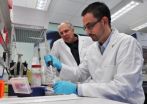(Press-News.org) Experts tout the health benefits of low-dose aspirin and omega-3 fatty acids found in foods like flax seeds and salmon, but the detailed mechanisms involved in their effects are not fully known. Now researchers reporting in the February 21 issue of the Cell Press journal Chemistry & Biology show that aspirin helps trigger the production of molecules called resolvins that are naturally made by the body from omega-3 fatty acids. These resolvins shut off, or "resolve," the inflammation that underlies destructive conditions such as inflammatory lung disease, heart disease, and arthritis.
"In this report, we found that one resolvin, termed resolvin D3 from the omega-3 fatty acid DHA, persists longer at sites of inflammation than either resolvin D1 or resolvin D2 in the natural resolution of inflammation in mice," explains senior author Dr. Charles Serhan of Brigham and Women's Hospital and Harvard Medical School. "This finding suggests that this late resolution phase resolvin D3 might display unique properties in fighting uncontrolled inflammation."
The researchers also confirmed that aspirin treatment triggered the production of a longer acting form of resolvin D3 through a different pathway. "Aspirin is able to modify an inflammatory enzyme to stop forming molecules that propagate inflammation and instead produce molecules from omega-3 fatty acids, like resolvin D3, that help inflammation to end," explains coauthor Dr. Nicos Petasis of the University of Southern California.
The team went on to reveal detailed information about resolvin D3. "We were able to produce by chemical synthesis both resolvin D3 and aspirin-triggered resolvin D3 in pure form, which allowed us to establish their complete structures and biological activities," says Dr. Petasis. When administered to human cells, both of these resolvins demonstrated potent anti-inflammatory actions. When given to mice, the compounds also stimulated the resolution of inflammation in the body.
"We also identified the human receptor that is activated by resolvin D3, which is critical in understanding how resolvin D3 works in the body to resolve inflammation," says Dr. Serhan. "With this new information, investigators will now also be able to study the pro-resolving and anti-inflammatory actions of resolvin D3 in other systems." In addition, researchers will be interested in determining which inflammation-associated diseases might be treated with this newly identified resolvin.
INFORMATION:
Chemistry & Biology, Dalli et al.: "Resolvin D3 and Aspirin-Triggered Resolvin D3 Are Potent Immunoresolvents."
Aspirin and omega-3 fatty acids work together to fight inflammation
2013-02-21
ELSE PRESS RELEASES FROM THIS DATE:
Why living against the clock is a risky business
2013-02-21
Living against the clock—working late-night shifts or eating at inappropriate times, for example—can come with real health risks, metabolic syndrome, obesity, and diabetes among them. Now, researchers reporting in Current Biology, a Cell Press publication, on February 21 have new evidence to explain why it matters not just what mice (or by extension, people) eat, but also when they eat it.
Insulin action rises and falls according to a 24-hour, circadian rhythm, the researchers found. What's more, mice unable to keep the time for one reason or another get stuck in an insulin-resistant ...
For monarchs to fly north, first they've got to chill
2013-02-21
Monarch butterflies are well known for their ability to fly 2,000 miles south from North America to Mexico each fall and back again in the spring. Now, researchers reporting in Current Biology, a Cell Press publication, on February 21 have evidence to show that the butterflies would just keep on heading south if it weren't for the chilly weather.
The findings help to explain why the butterflies spend the winter on frosty mountaintops. They also imply that global climate change could profoundly influence the monarchs' migrations, the researchers say.
"The monarchs need ...
Biomarker may identify neuroblastomas with sensitivity to BET bromodomain inhibitors
2013-02-21
PHILADELPHIA — Neuroblastoma, the most common malignant tumor of early childhood, is frequently associated with the presence of MYCN amplification, a genetic biomarker associated with poor prognosis. Researchers have determined that tumors containing MYCN amplification are sensitive to a new class of drugs, BET bromodomain inhibitors.
The researchers made this discovery in a preclinical study, which was funded in part by a Stand Up To Cancer Innovative Research Grant and was published in Cancer Discovery, a journal of the American Association for Cancer Research.
"BET ...
Life's tiniest architects pinpointed by Yale researchers
2013-02-21
If a genome is the blueprint for life, then the chief architects are tiny slices of genetic material that orchestrate how we are assembled and function, Yale School of Medicine researchers report Feb. 21 in the journal Developmental Cell.
The study pinpoints the molecular regulators of epigenetics – the process by which unchanging genes along our DNA are switched on and off at precisely right time and place.
"Our genome is like a landscape with lakes, mountains, and rivers, but it is not yet a community or a city full of buildings," said Haifan Lin, director of the ...
Research shows that coldness triggers northward flight in migrating monarch butterflies
2013-02-21
WORCESTER, MA – Each fall millions of monarch butterflies from across the eastern United States begin a southward migration in order to escape the frigid temperatures of their northern boundaries, traveling up to 2,000 miles to an overwintering site in a specific grove of fir trees in central Mexico. Surprisingly, a new study by scientists at the University of Massachusetts Medical School published in Current Biology, suggests that exposure to coldness found in the microenvironment of the monarch's overwintering site triggers their return north every spring. Without this ...
New study indicates avocado consumption may be associated with better diet quality
2013-02-21
IRVINE, Calif. (February 20, 2013) – New analysis of data from the National Health and Nutrition Examination Survey (NHANES) , a program of the Centers for Disease Control and Prevention (CDC), indicates that consuming avocados may be associated with better diet quality and nutrient intake level, lower intake of added sugars, lower body weight, BMI and waist circumferences, higher "good cholesterol" levels and lower metabolic syndrome risk. These results were published in the January 2013 issue of Nutrition Journal.
Specifically, the survey data (NHANES 2001-2008, ...
Early human burials varied widely but most were simple
2013-02-21
DENVER (Feb. 21, 2013) – A new study from the University of Colorado Denver shows that the earliest human burial practices in Eurasia varied widely, with some graves lavish and ornate while the vast majority were fairly plain.
"We don't know why some of these burials were so ornate, but what's striking is that they postdate the arrival of modern humans in Eurasia by almost 10,000 years," said Julien Riel-Salvatore, Ph.D., assistant professor of anthropology at CU Denver and lead author of the study. "When they appear around 30,000 years ago some are lavish but many aren't ...
Circadian clock linked to obesity, diabetes and heart attacks
2013-02-21
Disruption in the body's circadian rhythm can lead not only to obesity, but can also increase the risk of diabetes and heart disease.
That is the conclusion of the first study to show definitively that insulin activity is controlled by the body's circadian biological clock. The study, which was published on Feb. 21 in the journal Current Biology, helps explain why not only what you eat, but when you eat, matters.
The research was conducted by a team of Vanderbilt scientists directed by Professor of Biological Sciences Carl Johnson and Professors of Molecular Physiology ...
Bees attracted to contrasting colors when looking for nectar
2013-02-21
Flower colors that contrast with their background are more important to foraging bees than patterns of colored veins on pale flowers according to new research, by Heather Whitney from the University of Cambridge in the UK, and her colleagues. Their observation of how patterns of pigmentation on flower petals influence bumblebees' behavior suggests that color veins give clues to the location of the nectar. There is little to suggest, however, that bees have an innate preference for striped flowers. The work is published online in Springer's journal, Naturwissenschaften - ...
Scientists identify molecular system that could help develop treatments for Alzheimer's disease
2013-02-21
Scientists from the University of Southampton have identified the molecular system that contributes to the harmful inflammatory reaction in the brain during neurodegenerative diseases.
An important aspect of chronic neurodegenerative diseases, such as Alzheimer's, Parkinson's, Huntington's or prion disease, is the generation of an innate inflammatory reaction within the brain.
Results from the study open new avenues for the regulation of the inflammatory reaction and provide new insights into the understanding of the biology of microglial cells, which play a leading ...



